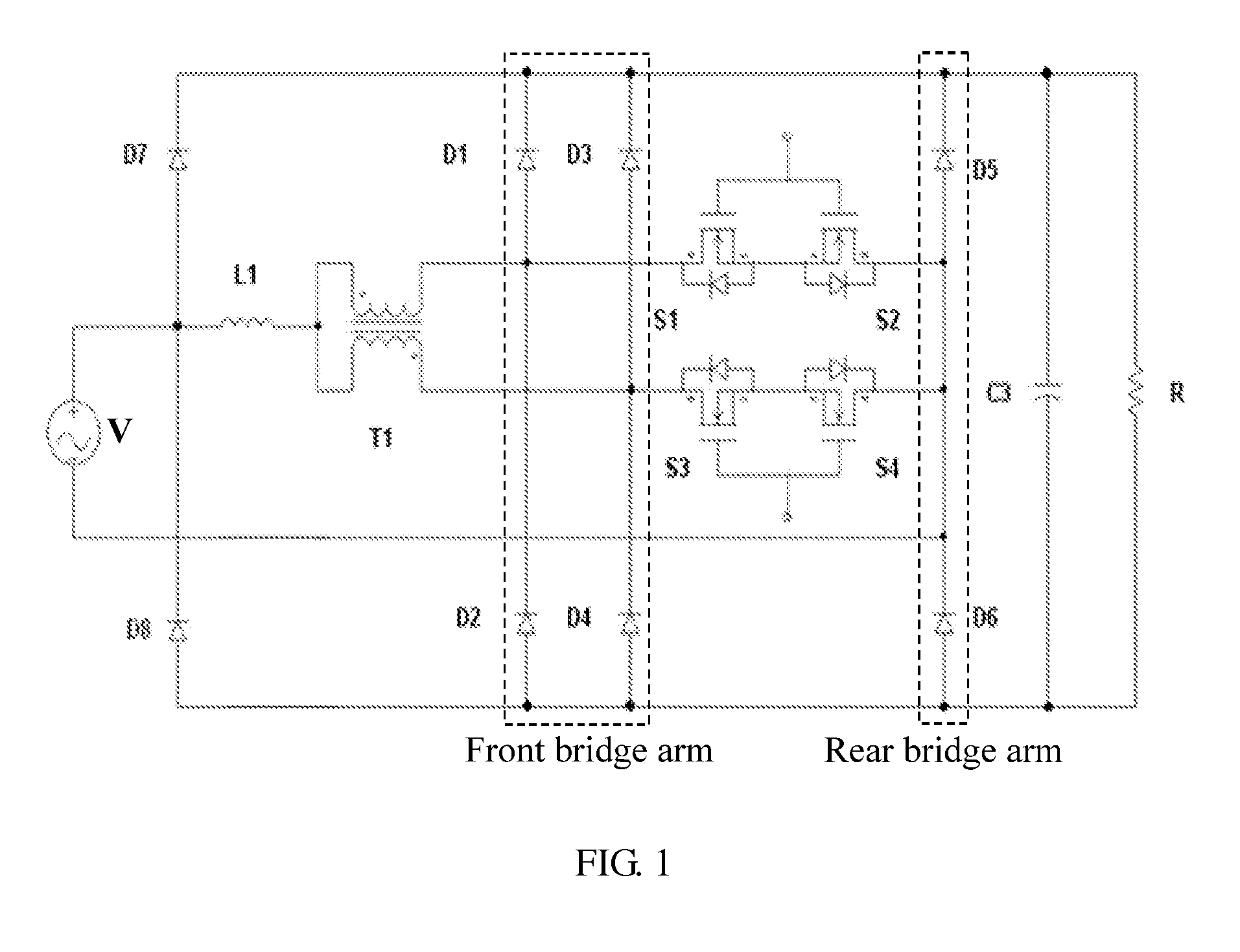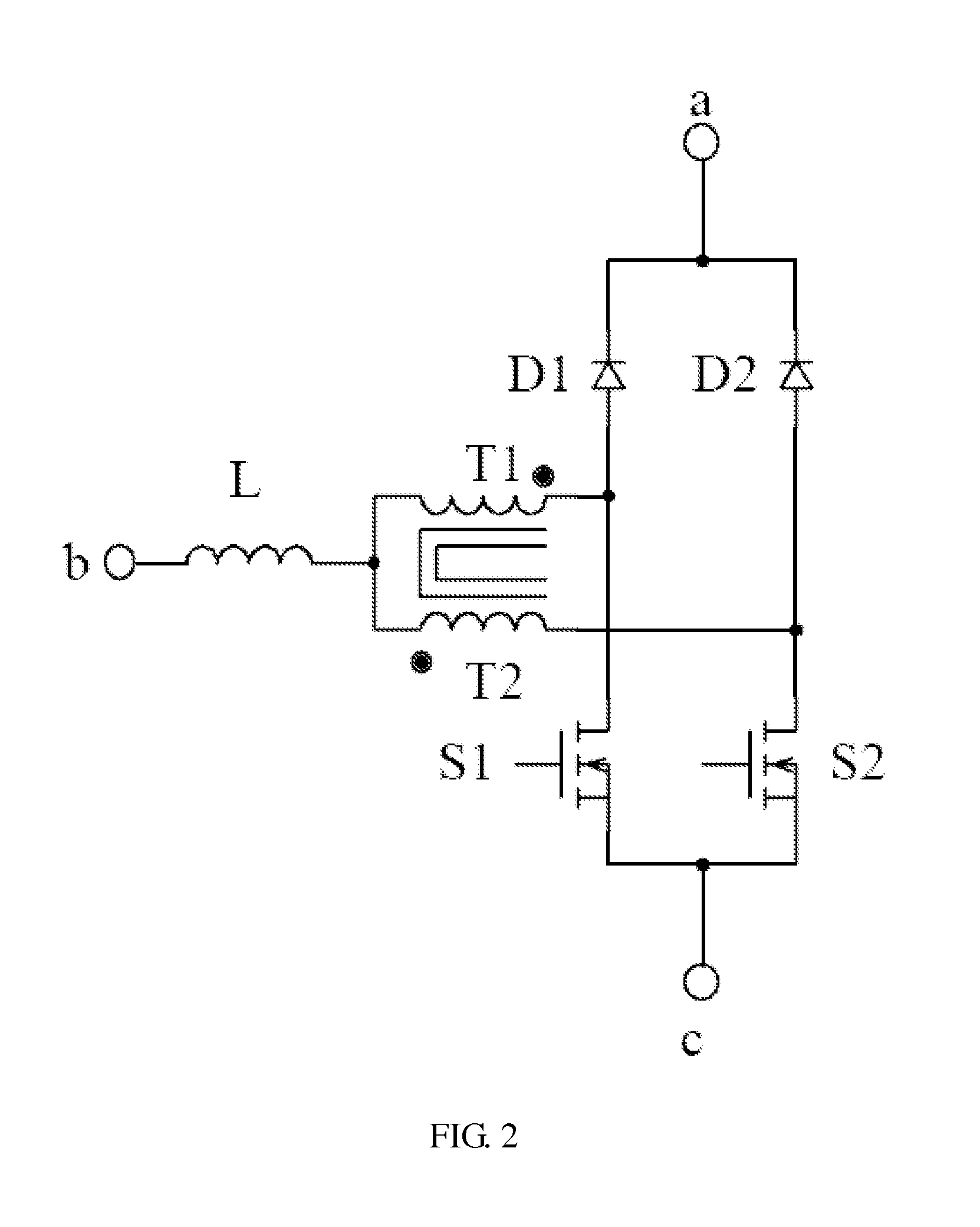Power factor correction converter and power factor correction conversion device
a conversion device and power factor technology, applied in the direction of conversion with intermediate conversion to dc, efficient power electronics conversion, energy industry, etc., can solve the problems of large size, low conversion efficiency and power density, and great effect of current passing through a switching transistor. achieve the effect of improving conversion efficiency, small circuit size and improving power density
- Summary
- Abstract
- Description
- Claims
- Application Information
AI Technical Summary
Benefits of technology
Problems solved by technology
Method used
Image
Examples
embodiment 1
[0027]As shown in FIG. 1, a power factor correction converter provided in an embodiment of the present invention includes two groups of bidirectional switches, that is, S1-S2 and S3-S4. Since coils in an autotransformer T1, front bridge arms, and the groups of the bidirectional switch are in one-to-one correspondence, both the number of the coils in the autotransformer and the number of the front bridge arms both are 2 according to the embodiment of the present invention. Furthermore, to achieve better technical effect, the autotransformer T1 in which two coils have the same number of turns is selected.
[0028]As an exemplary solution, the power factor correction converter according to the embodiment of the present invention further includes a protective bridge arm, the protective bridge arm includes two protective diodes D7 and D8 unidirectionally connected in series, an intermediate connection point located between D7 and D8 is connected to an input end of a boost inductor L1, and t...
embodiment 2
[0050]This embodiment is similar to Embodiment 1. The difference is that, as shown in FIG. 10, in this embodiment, a boost inductor is integrated in an autotransformer. For an application requiring low power, a boost inductor can be integrated in the autotransformer, so that a required boost induction value is obtained by adjusting a coupling coefficient M of the autotransformer, to further decrease the size and cost of a converter.
embodiment 3
[0051]This embodiment is similar to Embodiment 1. The difference is that, as shown in FIG. 11, in this embodiment, two clamped capacitors C1 and C2, which are configured to suppress common mode noise interference, are further included, where one end of the clamped capacitor C1 and one end of the clamped capacitor C2 are correspondingly connected to two ends of the AC input power grid, and the other end of the clamped capacitor C1 and the other end of the clamped capacitor C2 connected to each other are connected to one end of the bus filter capacitor C3. The two clamped capacitors C1 and C2 are capable of suppressing electromagnetic interference, especially common mode noise interference.
[0052]An embodiment of the present invention also provides a power factor correction conversion device. The power factor correction conversion device includes the foregoing power factor correction converter, an AC input power grid, and a load, where one end of the AC input power grid is connected to...
PUM
 Login to View More
Login to View More Abstract
Description
Claims
Application Information
 Login to View More
Login to View More - R&D
- Intellectual Property
- Life Sciences
- Materials
- Tech Scout
- Unparalleled Data Quality
- Higher Quality Content
- 60% Fewer Hallucinations
Browse by: Latest US Patents, China's latest patents, Technical Efficacy Thesaurus, Application Domain, Technology Topic, Popular Technical Reports.
© 2025 PatSnap. All rights reserved.Legal|Privacy policy|Modern Slavery Act Transparency Statement|Sitemap|About US| Contact US: help@patsnap.com



